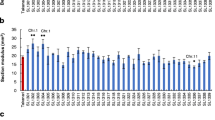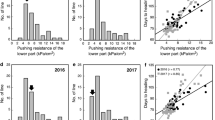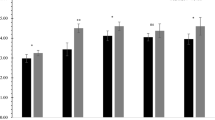Abstract
Varietal differences among ten rice cultivars showed that stem diameter is a key factor in lodging resistance (measured in terms of pushing resistance). Two near-isogenic lines (NILs) were selected from a series of chromosome segment substitution lines developed between cultivars Nipponbar and Kasalath, one containing a single stem diameter QTL (sdm8; NIL114), and another with four stem diameter QTLs (sdm1, sdm7, sdm8, sdm12; NIL28). Compared with the Nipponbare control, stem diameters were larger in NIL114 and NIL28 by about 7 and 39%, respectively. Pushing resistance in NIL28 was significantly greater than in Nipponbare, but NIL114 was similar to Nipponbare. The two NILs had greater weight of lower stem and culm wall thickness than Nipponbare. NIL28 had higher plant height, which is a negative effect on lodging resistance, than Nipponbare. The non-structural carbohydrate contents of NIL stems were higher than that of Nipponbare, whereas the silicon contents were lower in the NILs, and cellulose contents were lower only in NIL28. The basal internodes of the two NILs were significantly stiffer than those of Nipponbare. These results suggest that increasing stem diameter in rice breeding programs would improve lodging resistance, although the combination of multiple QTLs would be necessary to produce thicker stems with higher pushing resistance, whereas the higher plant height could also result from the combination of multiple QTLs.


Similar content being viewed by others
References
Atkins IM (1938) Relation of certain plant characters to strength of straw and lodging in winter wheat. J Agric Res 56:99–120
Bergmeyer HU, Bernt E (1974) Methods for determination of metabolites: carbohydrate metabolism: sucrose. In: Bergmeyer HU (ed) Methods of enzymatic analysis, vol 3. Academic Press, New York, pp 1176–1179
Berry PM, Spink J, Sterling M, Pickett AA (2003) Methods for rapidly measuring the lodging resistance of wheat cultivars. J Agron Crop Sci 189:390–401
Fouéré A, Pellerin S, Duparque A (1995) A portable electronic device for evaluating root lodging resistance in maize. Agron J 87:1020–1024
Hoshikawa K, Wang SB (1990) Studies lodging in rice plants. I. A general observation on lodged rice culms. Jpn J Crop Sci 59:809–814
Idris MD, Hossain MM, Choudhury FA (1975) The effect of silicon on lodging of rice in presence of added nitrogen. Plant Soil 43:691–695
Ishimaru K (2003) Identification of a locus increasing rice yield and physiological analysis of its function. Plant Physiol 133:1083–1090
Ishimaru K, Hirose T, Aoki N, Takahashi S, Ono K, Yamamoto S, Wu J, Saji S, Baba T, Ugaki M, Matsumoto T, Ohsugi R (2001a) Antisense expression of a rice sucrose transporter OsSUT1 in rice (Oryza sativa L.). Plant Cell Physiol 42:1181–1185
Ishimaru K, Kobayashi N, Ono K, Yano M, Ohsugi R (2001b) Are contents of rubisco, soluble protein and nitrogen in flag leaves of rice controlled by the same genetics? J Exp Bot 52:1827–1833
Ishimaru K, Shirota K, Higa M, Kawamitsu Y (2001c) Identification of quantitative trait loci for adaxial and abaxial stomatal frequencies in Oryza sativa. Plant Physiol Biochem 39:173–177
Ishimaru K, Yano M, Aoki N, Ono K, Hirose T, Lin SY, Monna L, Sasaki T, Ohsugi R (2001d) Toward the mapping of physiological and agronomic characters on a rice function map: QTL analysis and comparison between QTLs and expressed sequence tags. Theor Appl Genet 102:793–800
Islam MS, Peng S, Visperas RM, Ereful N, Bhuiya MSU, Julfiquar AW (2007) Lodging-related morphological traits of hybrid rice in a tropical irrigated ecosystem. Field Crops Res 101:240–248
Jones L, Ennos AR, Turner SR (2001) Cloning and characterization of irregular xylem4 (irx4): a severely lignin-deficient mutant of Arabidopsis. Plant J 26:205–216
Kashiwagi T, Ishimaru K (2004) Identification and functional analysis of a locus for improvement of lodging resistance in rice. Plant Physiol 134:676–683
Kashiwagi T, Madoka Y, Hirotsu N, Ishimaru K (2006) Locus prl5 improves lodging resistance of rice by delaying senescence and increasing carbohydrate reaccumulation. Plant Physiol Biochem 44:152–157
Keller M, Karutz Ch, Schmid JE, Stamp P, Winzeler M, Keller B, Messmer MM (1999) Quantitative trait loci for lodging resistance in a segregating wheat × spelt population. Theor Appl Genet 98:1171–1182
Kokubo A, Kuraishi S, Sakurai N (1989) Culm strength of barley: correlation among maximum bending stress, cell wall dimensions, and cellulose content. Plant Physiol 91:876–882
Kono M (1995) Physiological aspects of lodging. In: Matsuo T, Kumazawa K, Ishii R, Ishihara K, Hirata H (eds) Science of the rice plant, vol. 2, physiology, vol 2. Food and Agriculture Policy Research Center, Tokyo, pp 971–982
Li Y, Qian Q, Zhou Y, Yan M, Sun L, Zhang M, Fu Z, Wang Y, Han B, Pang X, Chen M, Li J (2003) BRITTLE CULM1, which encodes a COBRA-like protein, affects the mechanical properties of rice plants. Plant Cell 15:2020–2031
Lin HX, Yamamoto T, Sasaki T, Yano M (2000) Characterization and detection of epistatic interactions of 3 QTLs, Hd1, Hd2, and Hd3, controlling heading date in rice using nearly isogenic lines. Theor Appl Genet 101:1021–1028
Lin HX, Liang ZW, Sasaki T, Yano M (2003) Fine mapping and characterization of quantitative trait loci Hd4 and Hd5 controlling heading date in rice. Breed Sci 53:51–59
Ma JF, Yamaji N (2006) Silicon uptake and accumulation in higher plants. Trends Plant Sci 11:392–397
Ma QH, Xu Y, Lin ZB, He P (2002) Cloning of cDNA encoding COMT from wheat which is differentially expressed in lodging-sensitive and -resistant cultivars. J Exp Bot 53:2281–2282
Mackill DJ, Rutger JN (1979) The inheritance of induced-mutant semidwarfing genes in rice. J Hered 70:335–341
Mancuso N, Caviness CE (1991) Association of selected plant traits with lodging of four determinate soybean cultivars. Crop Sci 31:911–914
Matsuzaki A, Matsushima S, Tomita T, Katsuki E (1972) Analysis of yield-determining process and its application to yield-prediction and culture improvement of lowland rice. CIX. Effects of nitrogen top-dressing at full heading stage on lodging resistance, root activity, yield and kernel quality. Jpn J Crop Sci 41:139–146
Ohe M, Tamura A, Mimoto H (1996) Effects of deep water treatment on the growth of culm and the lodging resistance in japonica type paddy rice (Oriza sativa L.) cultivars. Jpn J Crop Sci 65:238–244
Ookawa T, Ishihara K (1993) Varietal difference of the cell wall components affecting the bending stress of the culm in relation to the lodging resistance in paddy rice. Jpn J Crop Sci 62:378–384
Peng S, Cassman KG, Virmani SS, Sheehy J, Khush GS (1999) Yield potential trends of tropical rice since the release of IR8 and the challenge of increasing rice yield potential. Crop Sci 39:1552–1559
Reddy N, Yang Y (2005) Structure and properties of high-quality natural cellulose fibers from corn stalks. Polymer 46:5494–5500
Sato K (1957) Studies on the starch contained in the tissues of rice plant. IV. Starch content in the culm related to lodging. Jpn J Crop Sci 26:19
Setter TL, Laureles EV, Mazaredo AM (1997) Lodging reduces yield of rice by self-shading and reductions in canopy photosynthesis. Field Crops Res 49:95–106
Spaner D, Rossnagel BG, Legge WG, Scoles GJ, Eckstein PE, Penner GA, Tinker NA, Brigges KG, Falk DE, Afele JC, Hyes PM, Mather DE (1999) Verification of a quantitative trait locus affecting agronomic traits in two-row barley. Crop Sci 39:248–252
Takahashi J (1960) Some thoughts on the lodging of rice plants. Agric Hortic 35:19–23
Takaya T, Miyasaka A (1983) Prevention of lodging of rice plants under direct sowing culture on well-drained paddy field. II Transition of the characters related to lodging resistance after the heading. Jpn J Crop Sci 52:7–14
Tanaka K, Murata K, Yamazaki M, Onosato K, Miyao A, Hirochika H (2003) Three distinct rice cellulose synthase catalytic subunit genes required for cellulose synthesis in the secondary wall. Plant Physiol 133:73–83
Tanksley SD (1993) Mapping polygenes. Annu Rev Genet 27:205–233
Taylor NG, Scheible W-R, Cutler S, Somerville CR, Turner SR (1999) The irregular xylem3 locus of Arabidopsis encodes a cellulose synthase required for secondary cell wall synthesis. Plant Cell 11:769–779
Terashima K, Akita S, Sakai N (1992) Eco-physiological characteristics related with lodging tolerance of rice in direct sowing cultivation. Jpn J Crop Sci 61:380–387
Terashima K, Ogata T, Akita S (1994) Eco-physiological characteristics related with lodging tolerance of rice in direct sowing cultivation. II. Root growth characteristics of tolerant cultivars to root lodging. Jpn J Crop Sci 63:34–41
Togawa E, Kondo T (1999) Change of morphological properties in drawing water-swollen cellulose films prepared from organic solutions: a view of molecular orientation in the drawing process. J Polym Sci B Polym Phys 37:451–459
Tripathi SC, Sayre KD, Kaul JN, Narang RS (2003) Growth and morphology of spring wheat (Triticum aestivum L.) culms and their association with lodging: effects of genotypes, N levels and ethephon. Field Crops Res 84:271–290
Vázquez MD, Poschenrieder C, Corrales I, Barceló J (1999) Change in apoplastic aluminum during the initial growth response to aluminum by roots of a tolerant maize variety. Plant Physiol 119:435–444
Vignols F, Rigau J, Torres MA, Capellades M, Puigdomènech P (1995) The brown midrib3 (bm3) mutation in maize occurs in the gene encoding caffeic acid O-Methyltransferase. Plant Cell 7:407–416
Watanabe T (1997) Lodging resistance. In: Matsuo T, Futsuhara Y, Kikuchi F, Yamaguchi H (eds) Science of the rice plant, vol 3, Genetics, vol 3. Food and Agriculture Policy Research Center, Tokyo, pp 567–577
Weber CR, Fehr WR (1966) Seed yield losses from lodging and combine harvesting in soybeans. Agron J 58:287–289
Won JG, Hirahara Y, Yoshida T, Imabayashi S (1998) Selection of rice lines using SPGP seedling method for direct seeding. Plant Prod Sci 1:280–285
Yagi T (1983) Studies on breeding for culm stiffness in rice. 1. Varietal differences in culm stiffness and its related traits. Jpn J Breed 33:411–422
Yang J, Zhang J, Huang Z, Zhu Q, Wang L (2000) Remobilization of carbon reserves is improved by controlled soil-drying during grain filling of wheat. Crop Sci 40:1645–1655
Yang J, Zhang J, Wang Z, Zhu Q (2001) Activities of starch hydrolytic enzymes and sucrose-phosphate synthase in the stems of rice subjected to water stress during grain filling. J Exp Bot 52:2169–2179
Yano M (2001) Genetic and molecular dissection of naturally occurring variation. Curr Opin Plant Biol 4:130–135
Zuber U, Winzeler H, Messmer MM, Keller B, Schmid JE, Stamp P (1999) Morphological traits associated with lodging resistance of spring wheat (Triticum aestivum L.). J Agron Crop Sci 182:17–24
Acknowledgments
This work was supported by the Program for the Promotion of Basic Research Activities for Innovative Biosciences (PROBRAIN) and Research Fellowships from the Japan Society for the Promotion of Science for Young Scientists. We thank Dr. Masahiro Yano, NIAS, for kindly providing near-isogenic lines, and Tomoe Yanai, Mieko Kuroishi, and Eiko Iimura, NIAS, for their help with carbohydrate measurements.
Author information
Authors and Affiliations
Corresponding author
Additional information
Communicated by M. Kearsey.
Rights and permissions
About this article
Cite this article
Kashiwagi, T., Togawa, E., Hirotsu, N. et al. Improvement of lodging resistance with QTLs for stem diameter in rice (Oryza sativa L.). Theor Appl Genet 117, 749–757 (2008). https://doi.org/10.1007/s00122-008-0816-1
Received:
Accepted:
Published:
Issue Date:
DOI: https://doi.org/10.1007/s00122-008-0816-1




